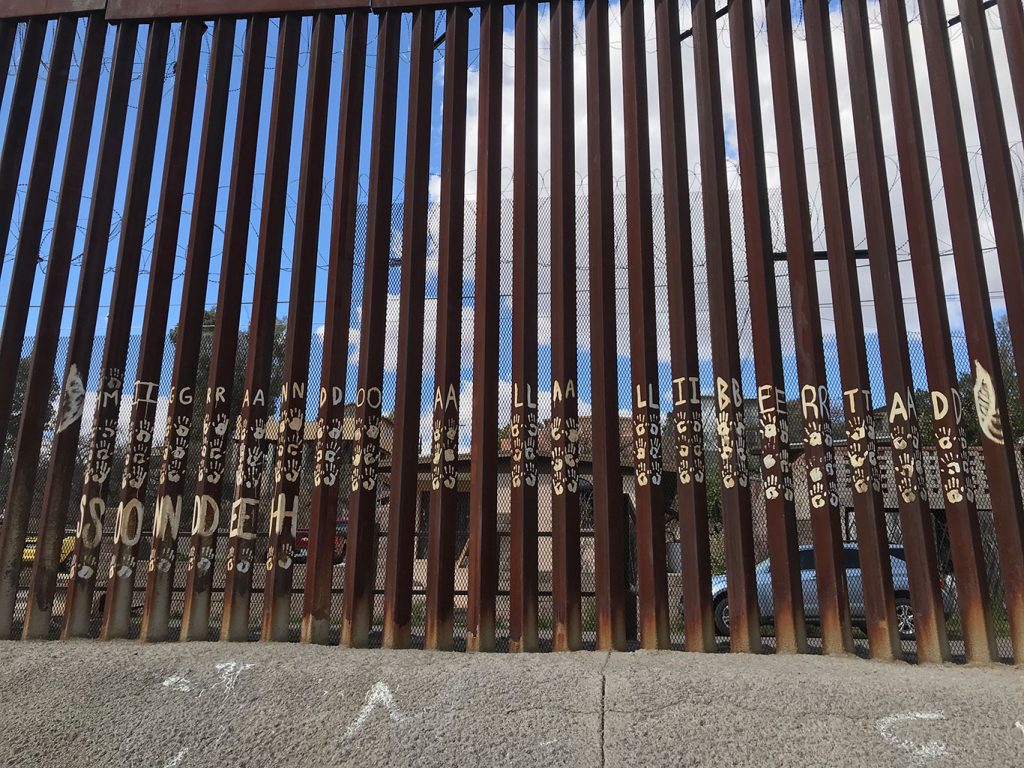Q: Seven years ago you left your position as rector at Fordham to take over leadership of the newly combined USA Northeast Province of the Society of Jesus. What did you learn from your time that you’ll be bringing back to the University?
A: A large part of bringing together the New York and the New England provinces was to focus on the core features that united us. The different missions are all rooted in a common appreciation of how God labors in the world and through each of us, and our response is one of gratitude, love, and generosity.
Having been at Fordham for 15 years, I have a special interest in Jesuit higher education. What is unique about Jesuit higher education is that same spiritual foundation we’re focused on in the province. We’re in the business of not only preparing people for careers, but also informing how they see the world, how they orient themselves toward God and other people. No matter what profession they pursue, they put those gifts at the service of others, and especially the poor, the marginalized, and those members of society who are ignored or overlooked.
I think sometimes we forget to articulate that we’re not here only to introduce people to great ideas, but also to make them “men and women with and for others.” My role is to work with others in the University to keep our focus on why we are engaged in the business of Jesuit education here.
Q: What will be some of your biggest priorities?
A: One of my biggest priorities is working with the Board of Trustees. In 2013, I was asked to coordinate a meeting of the board chairs of 28 Jesuit colleges and universities with Father General Adolfo Nicolás, S.J. He said to them, ‘You are the leaders of the colleges and universities.’ In a legal sense, that’s absolutely true, but it’s also true in a mission sense. The board allocates finances and makes decisions that help people like me and others with overseeing and implementing the mission.
Another is faculty. I was a full-time member of the faculty for 15 years, so I know that faculty are very busy. The challenge is to help faculty have some time to reflect on that key question, ‘Why am I doing this in the context of a Jesuit university?’ That’s going to be through a series of talks and presentations, and through personal reflection and exploration. I’m working closely with Jim McCartin in creating initiatives that will include seminars and retreats.
We also want to expand the work that Lito Salazar, S.J., and campus ministry does. We want to serve the Catholic students and those who are interested in explicit religious practices, but there are others who I’m sure would benefit from programs designed to open them up to a spiritual worldview.
We also have the Center for Community Engaged Learning, which Dr. Julie Gafney just took over last year. They’ve increased the number of courses that are offered where faculty engage with students who participate in community engagement projects and integrate that work with academic work. It’s a wonderful opportunity to be of service to the poor and marginalized right here in the Bronx community.
David Gibson has been doing some wonderful talks, discussions, lectures, and seminars with the Center on Religion and Culture. I’m going to be working with him to expand that programming to include topics that would be of particular interest to younger people.
Q: Talk to me about life trap theory, which is your area of expertise in psychology. Is that going to play a part in how you approach your new role?
A: What gets in the way of productively focusing on mission are our personal, and you might say institutional, life traps. One of the life traps is overdependence. So for example, students or faculty might say, ‘Well, mission is the work of others and, I’ll let them do it.’ That’s kind of a trap because it’s shirking a responsibility that is really incumbent on all of us to participate in.
Q: This year is the Ignatian Year, which celebrates the 500th anniversary of the “cannonball moment” of St. Ignatius, the founder of the Jesuits. Why is Jesuit spirituality so important even after five centuries?
A: It was May 20 of this year that was the 500th anniversary of St. Ignatius being hit by a cannonball when he was a soldier. It was a turning point in his life because that wound literally laid him on his back, and during his convalescence, he started to read Lives of the Saints and started to think, ‘Maybe this whole ambition of worldly success is not that important—what’s really important is following Jesus Christ.’
What you might call the “cannonball moment” is what Jesuit education is all about. We’re not going to shoot students with cannonballs, but hopefully in the course of their time in a Jesuit school, their worldview gets shaken, maybe shattered, certainly rocked, and they get opportunities to radically rethink who they are, what they are, and what their purpose in life is, just as Ignatius did. So this year, we’re celebrating a focus on conversion and higher education. That’s the core mission.
Q: Does it feel more relevant given what a tumultuous time this is?
A: Pope Francis [who is a Jesuit]had something to say about that. He did a series of interviews recently and they were published in a book called Let Us Dream (Simon & Schuster, 2020). He says the pandemic is just like the cannonball for the whole world, and he hopes that the new normal will be a more radically transformed world, where we come out of it with a heightened awareness of the needs of others. He sees it as a fertile, if extraordinarily painful, moment for us.
]]>
 The magazine, which is published biannually, is run by a board comprised of both lay people and clergy, and is distributed to all 27 Jesuit colleges and universities in the United States.
The magazine, which is published biannually, is run by a board comprised of both lay people and clergy, and is distributed to all 27 Jesuit colleges and universities in the United States.
McCartin, a member of the seminar’s board from 2013-2016, is the first lay person to assume leadership of the seminar, succeeding the late Patrick J. Howell, S.J. He said the post, which is akin to a publisher, allows him to combine two of his greatest passions: Fordham University and Jesuit education.
“Jesuit higher education is one of the most important things on the landscape of contemporary American higher education, in terms of the moral development and the ethical imperatives that it seeks to instill in students, and the possibilities for developing leaders for the world we live in,” he said.
It’s a role that McCartin has actually been pursuing with the University since he stepped down from the Center on Religion Culture in 2017. For the last three years, he’s been working with Fordham faculty to enhance their understanding of, and engagement with, Fordham’s mission and help them see how that mission can enhance their lives, their work, and the whole Fordham community. Last year, he was part of a contingent of faculty that traveled to the southern border to bear witness to the immigration crisis taking place there.
“In a sense, the seminar and leadership of it gives me the ability to bring some of my work locally with our faculty to a new, national level,” he said.
He’s especially excited to take on the role as the first lay leader of the group, and credited Joseph M. McShane, S.J., president of Fordham; Dennis Jacobs, Ph.D., provost and senior vice president for academic affairs; and Eva Badowska, Ph.D., dean of the Faculty of Arts and Sciences, with making it possible. In many ways, it’s a logical step in the Society of Jesus’ work to expand its influence outside of its current membership.
“If the Society of Jesus today calls itself to the work of reconciliation in the complicated world that we live in, part of the work of reconciliation is being able to share the riches of Jesuit spirituality and the intellectual orientation of Jesuit life with a full array of collaborators outside of the Society of Jesus,” McCartin said.
When it comes to the magazine, the next two issues will be devoted to the four priorities that the Society of Jesus’ Superior General Arturo Sosa, S.J., laid out last year: Showing the way to God through the Spiritual Exercises developed by Saint Ignatius Loyola, caring for our common home, journeying with the young, and walking with marginalized people. McCartin said he also wants to update the magazine’s messaging to reflect best practices of publishing. In addition to a traditional printed product, the magazine will also embrace online publishing and social media. Recent web features have focused on the ways university communities are coping with the novel coronavirus outbreak.
“Every issue, article, or post we create should really reflect a desire to ensure that we are up to date and sophisticated in how we are thinking about the present and future of Jesuit higher education,” he said.
“If this publication can help us as a community of 27 to think creatively about the next steps for us to think about what it means to be educators in the Jesuit tradition, I would like that for be the case.”
]]>“The U.S.-Mexico borderlands is a place where the Earth just swallows up bodies,” says Leo Guardado, Ph.D.
He doesn’t mince words about the humanitarian crisis at the border. In May, 144,278 migrants were taken into custody by the U.S. Border Patrol, the highest monthly total in more than a decade. And each year, the agency finds hundreds of corpses—the remains of men, women, and children who died traversing the vast desert and mountain regions on both sides of the dividing line.
The Trump administration’s efforts—separating migrant parents and children, deploying U.S. troops to the border, sending asylum-seekers to Mexico to await immigration court hearings—have not reduced the number of people fleeing poverty and violence in Central America to enter the U.S. without authorization.
Guardado knows all too well the pain and fear that families suffer when making the dangerous decision to migrate to the U.S. He was just 9 years old in 1991 when he and his mother made the nearly 3,000-mile trek from their mountain town in El Salvador.
Today, he is an assistant professor of theology at Fordham. And while the federal government remains deeply divided on how to handle the crisis, he views it not as a political abstraction but as a theological issue.
A Migrant’s Journey
Guardado was born in a rural town in northern El Salvador during the country’s civil war. As he approached his 10th birthday, his mother feared that he would soon be conscripted by the army or the guerrillas.
She was determined to move him from harm’s way. Family in the U.S. loaned them money, and Guardado said his grandfather probably sold what little cattle the family had to help pay for his and his mother’s journey. He remembers crying with his grandfather as they said their goodbyes, both of them knowing they might never see each other again. And they never did.
“We got on a bus, and I counted palm trees,” Guardado said. He learned two English phrases from his mother—“‘Thank you,’ ‘I’m sorry’—how to be grateful and how to ask for forgiveness,” he said. “These were the only two phrases that I had in my English vocabulary leaving El Salvador.”
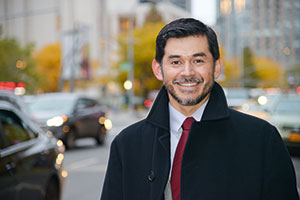
He thinks he counted palm trees as a way of remembering his country. By the time he reached the hundreds, he fell asleep. He awoke in Guatemala, and from there his memory skips through a series of glimpses, mostly involving walking: “A lot. Many days. Under the moonlight.” He traveled with a group of about 15 migrants who followed a “coyote,” a paid guide, for the length of the journey.
He remembers being crammed into false compartments of trailers, packed together “like sardines” for five hours at a time. In Tijuana, they crossed beneath a barbed-wired fence patrolled by jeeps, and in darkness jammed into a small taxi like a “clown car,” which took them over back roads to a white van that ultimately brought them to San Diego.
He and his mother eventually connected with family in Los Angeles, where Guardado was educated by the De La Salle Christian Brothers at Cathedral High School. He earned a full scholarship to attend Saint Mary’s College of California, and it was in his first year there that he finally received legal residency status. He became a U.S. citizen in 2010.
Religion, Politics, and Sanctuary
Saint Mary’s is not far from a Trappist monastery, where Guardado spent a year before earning a master’s degree in theology at the University of Notre Dame. For two years, he directed the social justice ministry at a Catholic church in Tucson, Arizona. Then he returned to the monastery for what he thought would be the rest of his life. But there, in isolation, ideas began to “percolate,” he said, and he returned to Notre Dame, where he earned a doctorate in theology.
He initially studied early church history, but his focus changed after he took a course with Gustavo Gutiérrez, O.P., the father of liberation theology, which emphasizes the perspective of the poor.
“I began to crack open the possibility that my own experience, my community’s experience, and the historical reality of Latin America—poverty, oppression, war, violence—that all of this was raw material out of which I could do theological reflection,” Guardado said.
In his dissertation, he wrote about the 1980s sanctuary movement, when hundreds of Catholic churches provided a safe haven for refugees from Central America. Today, he said, only a handful of churches in the U.S. are willing to take that risk. He said bishops will often say providing sanctuary is illegal or too political.
“The term sanctuary often mistakenly gets reduced to politics,” he said. “In light of human displacement worldwide and 11 million undocumented here in the U.S., if we’re to be a church of and for the poor, then you can’t just say ‘no.’ You have to engage with the question theologically. Otherwise, one can argue that it’s an ecclesial sin of omission.”
Guardado said the point of theology is not just to “do religious metaphysics” but to deal with contemporary issues head-on. He is developing a course on migration and theology that will include a visit to the U.S.-Mexico border.
“I want my students to ask: How does theological thinking change the world? How does it change history? How does it leave an impact so that it’s not just thinking about God but actually aims to transform the world?”
Bearing Witness at the Border
Guardado is far from being the only Fordham professor engaging with the humanitarian crisis at the border.
During spring break in March, a group of 10 faculty members went to see it for themselves. They visited the Kino Border Initiative, a consortium of six Catholic organizations in the border city of Nogales—both on the Arizona side and the Sonora, Mexico, side—that serves deportees and asylum-seekers and promotes a spirit of international solidarity.
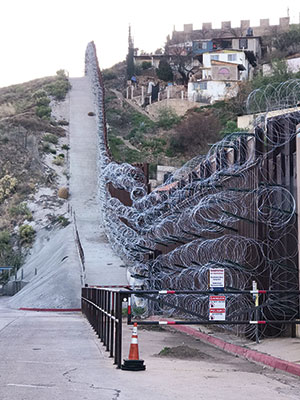
Faculty members raised $13,000 to buy toiletries and necessities for the migrants, and Fordham’s Office of Mission Integration and Planning funded the trip. Michael C. McCarthy, S.J., vice president for mission integration and planning, said it was a necessity, given how migration is now a major global challenge.
“Because this is such a major social issue and it impacts questions of justice, what we want to be as a society, and how a place like Fordham, as a Jesuit university, tries to develop students, we decided the border would be a great site for this immersion experience for a diverse group of faculty members,” he said.
Jacqueline Reich, Ph.D., chair of the Department of Communications and Media Studies, and theology professor James McCartin, Ph.D., acting associate provost of the University, co-led the trip.
It was the second time Reich went to Nogales, having worked with the Kino Initiative in January 2018. Although only 14 months had passed, the experience was very different, she said. As before, the group stayed overnight in Arizona and crossed the border to work in a comedor, or cafeteria, in Mexico, that provided meals to people waiting for asylum claims to be heard in the United States.
In 2018, she said, they would typically have one seating of 40 to 50 people—mostly men, a few women, and very few unaccompanied minors. This time, there were multiple seatings with 300 people per meal.
“We spent a lot of time holding babies while people could eat, or entertaining children, or sitting and talking to groups of families that had left Honduras, Guatemala, or regions of Mexico that were affected by gang violence and poverty,” she said.
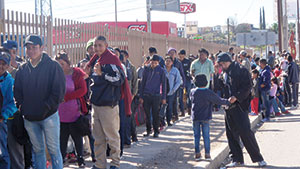
In addition to serving meals, the group hosted a party at a women’s shelter, met with Border Patrol agents, and hiked along the border to understand the conditions there.
They also attended an “Operation Streamline” hearing in Tucson, Arizona, where immigrants appeared in a group before a judge, who often deported them for being in the U.S. illegally after asking two quick questions.
Glenn Hendler, Ph.D., a professor of English and American studies and acting chair of the English department, said he was surprised to learn that a wall was constructed through the middle of the city of Nogales in 1994, long before President Donald Trump made building a border wall his signature campaign promise.
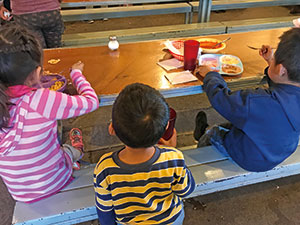
Although he does not speak Spanish, he was able to connect with a 6-year-old girl at the comedor whose father was washing dishes nearby.
“It was an incredible joy to make a child who was going through a horrific experience laugh,” he said. “The next day, we were serving a meal, and I heard a little girl yelling ‘hola, hola,’ and it was the same little girl again. She was happy to see me, and I was happy to see her. But there were so many people there that they just got rushed out, so I never got to say goodbye to this little girl. For some reason, that just broke my heart.”
Speaking with the Border Patrol complicated the picture for Hendler because it showed how difficult the job is, he said. But it did not change his mind about the moral implications of the situation. In fact, he said that by then he felt more emotionally connected to what had previously been an abstract concept.
‘Accompany, Humanize, Complicate’
Carey Kasten, Ph.D., associate professor of Spanish, was moved by learning specific details of the migrants’ experience, like why black water bottles are a must for those crossing the border at night. (They don’t reflect moonlight.) “We were told to accompany, humanize, and complicate,” she said. “To see those real items that our guide had collected on hikes through the desert, and also to see people get out of a van who’d been deported and go into the soup kitchen we were working in [in Mexico], was something that really stood out.”
McCartin, the theology professor who co-led the trip, recalled a conversation with a man from Honduras who asked if all Americans consider him and his fellow migrants to be criminals. “I said, ‘Oh gosh, no, I have no problem with you.’ This guy was like, ‘Really? I can’t believe that.’ I said, ‘No, I can see how you have a sense that that’s how Americans talk about you, and there are plenty of them that do, but there are also a lot of us that don’t really begrudge you trying to have a better life,’” he said.
“This moment of his being surprised that we’re not unified in our attitudes toward people at the border—a lightbulb went on for this guy, and I’ll remember that.”
—Story co-author: Patrick Verel
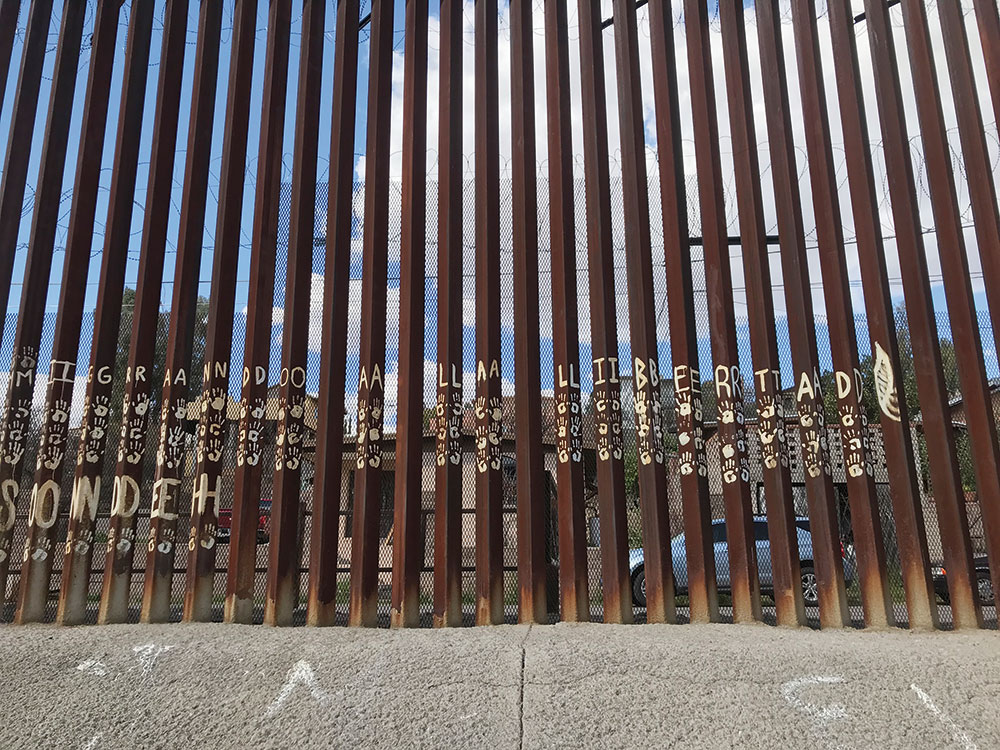
This spring, a group of 10 Fordham faculty members traveled there to see it for themselves. From March 17 to 22, they visited the Kino Border Initiative, a consortium of six Catholic organizations in the border city of Nogales—both on the Arizona side and the Sonora, Mexico side. Kino aims to promote border and immigration policies that affirm the dignity of the human person and a spirit of binational solidarity.
The trip was funded by Fordham’s Office of Mission Integration and Planning and featured faculty from arts and sciences, the Graduate School of Social Service, the Graduate School of Education, the Gabelli School of Business, and the Law School. The group raised $13,000 to purchase toiletries and necessities for the migrants and documented their time on a blog.
Big Changes in Just One Year
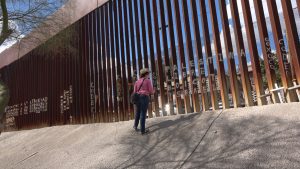
Jacqueline Reich, Ph.D., professor of communications and chair of the Department of Communications and Media Studies, co-led the trip along with Associate Professor of Theology and Acting Associate Provost James McCartin, Ph.D. It was Reich’s second time in Nogales, having worked with Kino in January 2018. Although only 14 months had passed since her last visit, the experience was very different, she said. As before, the group stayed overnight in Arizona and crossed the border to work in a comedor, or cafeteria, in Mexico, that provided meals to people waiting for asylum claims to be heard in the United States.
In 2018, she said, they would typically have one seating of 40 to 50 people—mostly men, a few women, and very few unaccompanied minors. This time, there were multiple seatings with 300 people per meal.
“We spent a lot of time holding babies while people could eat, or entertaining children, or sitting and talking to groups of families that had left Honduras, Guatemala, or regions of Mexico that were affected by gang violence and poverty,” she said.
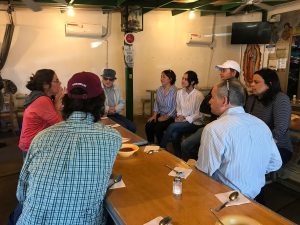
In addition to serving meals, the group hosted a party at a women’s shelter, met with border patrol agents, and hiked along the border to understand the conditions there. They also attended an “Operation Streamline” hearing in Tuscon, Arizona, where immigrants appear in a group before a judge, who often deported them for being here illegally after two quick questions.
Glenn Hendler, Ph.D., a professor of English and American studies and acting chair of the English department, said he knew a little about the crisis at the border before heading there, but learned a lot from the trip. He was surprised to learn, for instance, that a wall was constructed through the middle of the Nogales in 1994, long before President Donald Trump made building a border wall his signature campaign promise.
‘Never Got to Say Goodbye’
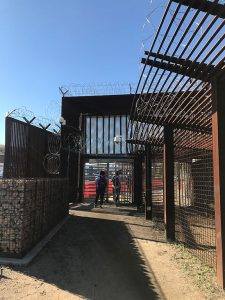
Although he does not speak Spanish, he was able to connect with a 6-year old girl at the comedor whose father was washing dishes nearby.
“It was an incredible joy to make a child who was going through a horrific experience laugh,” he said.
“The next day, we were serving a meal, and I heard a little girl yelling ‘hola, hola,’ and it was the same little girl again. She was happy to see me, and I was happy to see her. But there were so many people there, that they just got rushed out. So, I never got to say goodbye to this little girl. For some reason, that just broke my heart.”
Speaking with the border patrol complicated the picture for Hendler because it showed how difficult the job is, but it did not change his mind about the moral implications of the situation. In fact, he said he now felt more emotionally connected to what had previously been an abstract concept. He also said that the bonding experience he had with the other nine faculty was “very powerful.”
Accompany, Humanize, Complicate
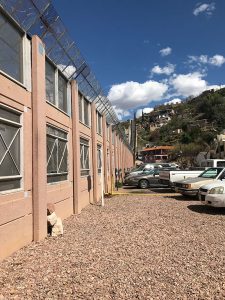
Carey Kasten, Ph.D., associate professor of Spanish, echoed this, saying she was moved by the possibility of future projects at Fordham. Her scholarship touches on issues related to the border, so she was familiar with the situation. But she was moved to learn things like why black water bottles are a must for those crossing the border at night. (They don’t reflect moonlight).
“We were told to accompany, humanize, and complicate. To see those real items that our guide had collected on hikes through the desert, and also to see people get out of a van who’d been deported and go into the soup kitchen we were working in, was something that really stood out,” she said.
She was also shocked at the level of needless suffering taking place. When people are deported to Mexico for instance, they are given back any cash they had on them when they were apprehended in the form of a check. But the checks are only cashable in the United States, so once a week, a nonprofit group called No More Deaths visits the comedor to help people cash them. She also wasn’t impressed with the judge who spoke to them after presiding over the deportation proceedings.
“He said, ‘I’m just carrying out my marching orders.’ And I thought, ‘You’re a lawyer. You could leave and get a different job.’”
She felt more empathy toward border patrol agents. “They have fewer choices, and their job sounds really hard,” she said. “I found it really complicated to parse it all.”
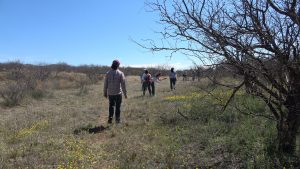
McCartin said the goal of the trip was to give faculty members an experience different from their everyday work life that would also then affect their work life. The group will reunite soon for debriefing and discussion of possible future plans.
One conversation that will always stay with him happened when a man from Honduras asked him if Americans all thought they were criminals.
“I said ‘Oh gosh, no, I have no problem with you.’ This guy was like, ‘Really? I can’t believe that.’ I said ‘No, I can see how you have a sense that that’s how Americans talk about you, and there are plenty of them that do, but there are also a lot of us that don’t really begrudge you trying to have a better life,’” he said.
“This moment of his being surprised that we’re not unified in our attitudes toward people at the border—a lightbulb went on for this guy, and I’ll remember that.”
Carrying Their Stories Back Home
Michael C. McCarthy, S.J., vice president and presidential assistant for planning in the Office of Mission Integration and Planning, said the trip was a necessity, given how immigration is now a major global challenge.
“Because this is such a major social issue and it impacts questions of justice, what we want to be as a society, and how a place like Fordham, as a Jesuit university, tries to develop students, we decided the border would be a great site for this immersion experience for a diverse group of faculty members,” he said.
Reich is making sure the issue lives on, having structured the syllabus of one of her spring classes, Films of Moral Struggle, to include representations of borders and migration. The class is also sending Easter cards to people in detention at the border to bring a little color and humanity into their lives, she said.
Above all, she said she’ll hold onto memories of conversations with the migrants she met, like one with a man at the comedor who was sporting a University of Michigan hat. He’d lived in the U.S. for 22 years before being deported after being stopped for a traffic violation.
“I will always carry their stories with me,” Reich said.
Photos courtesy of Fordham faculty.
]]>
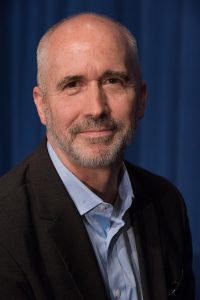
David Gibson, an award-winning journalist and co-author of Finding Jesus: Faith. Fact. Forgery (St. Martin’s Press, 2015), has been named the new director of Fordham University’s Center on Religion and Culture (CRC). Gibson will start on July 1, and succeeds James P. McCartin, Ph.D., a historian of American Catholicism who will return to full-time teaching after leading the center for six years.
Joseph M. McShane, S.J., president of Fordham, praised Gibson’s appointment, “We would be hard-pressed to find someone more uniquely suited than David Gibson as CRC’s next director,” he said.
“He brings to the post a wealth of experience writing about the modern church and the complexities of contemporary religious life in the United States and abroad, experience which will inform our discussions about our past and future.”
Gibson is well-versed in issues of faith, having begun his career in journalism in Rome at Vatican Radio, which, like Fordham, is connected to the Society of Jesus.. During his time there, Gibson covered many of Pope John Paul II’s travels, and the election of Pope Benedict XVI. He detailed the latter in The Rule of Benedict: Pope Benedict XVI and His Battle with the Modern World (HarperCollins, 2007).
Upon returning to the United States in 1990, Gibson wrote for media such as The New York Times, The Washington Post and The Wall Street Journal. He also wrote for Catholic publications, including America magazine and Commonweal, and has been honored several times as the nation’s top religion reporter.
Gibson has co-written and co-produced several documentaries for CNN and the History Channel including Finding Jesus: Faith. Fact. Forgery, a CNN series based on his book. He is also a frequent television and radio commentator on religion news.
Originally from Plainfield, New Jersey, Gibson graduated from Furman University with a degree in European history. He now resides in Brooklyn with his wife and daughter.
Founded in 2004 by Peter and Margaret Steinfels, the CRC confronts the questions arising at the intersection of religious traditions and contemporary culture. Drawing on New York’s leading role in intellectual and literary life, the visual and performing arts, politics, media, diplomacy, and humanitarian activities, CRC programs aim to promote intellectual enrichment and affirm Fordham’s leadership role as a shaping force in the public discourse.
“The center is a crucial part of Fordham’s engagement with the intellectual, religious, and spiritual life of New York and beyond, and we look forward to David’s enthusiasm and insights in carrying that mission forward through thought-provoking conversations,” said Michael C. McCarthy, S.J., vice president for mission integration and planning.
—Veronika Kero
]]>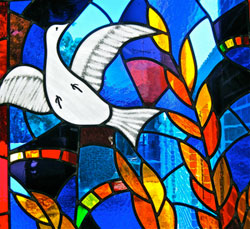 American Catholic religious sisters have had a dramatic impact on the church for generations. From building an extensive parochial school system to pioneering higher education for women, Catholic sisters have continually expanded their ministries since the Second Vatican Council’s call for renewal in the 1960s.
American Catholic religious sisters have had a dramatic impact on the church for generations. From building an extensive parochial school system to pioneering higher education for women, Catholic sisters have continually expanded their ministries since the Second Vatican Council’s call for renewal in the 1960s.
An upcoming panel presentation at Fordham will examine how the sisters’ ministry has changed the face of the church and what they are called to do today.
Call Response: How American Catholic Sisters Shaped the Church Since Vatican II
Tuesday, Dec. 11
6 p.m.
Pope Auditorium | Lowenstein Center | Lincoln Center Campus
113 West 60th Street
Co-sponsored by Fordham’s Center on Religion and Culture, the panel will discuss Catholic sisters’ diverse ministries, including social activism and missionary work, and their tireless championing of human dignity and rights.
“It may be because of images of nuns in our pop culture, but people too often overlook sisters’ profound importance in shaping religion and society,” said James P. McCartin, director of the center. “Our goal with this forum is to allow a group of outstanding women to speak about how their communities changed the Church by responding to some of the most pressing challenges in recent history.”
The event is free and open to the public. To RSVP, call (212) 636-7347 or email [email protected]. For more information, visit the event website.
Call Response is co-sponsored by the Francis and Ann Curran Center for American Catholic Studies.
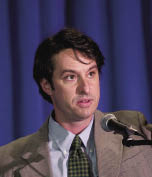
Photo by Leo Sorel
McCartin comes to Fordham from Seton Hall University, where he has been associate professor of history and associate director of the Center for Catholic Studies.
The recipient of numerous research fellowships and the author of many articles, encyclopedia articles and reviews, he has specialized in questions of Catholicism, public life and American culture. He will be a visiting professor at Fordham.
Founded in 2004 by Peter Steinfels and Margaret O’Brien Steinfels, the Fordham Center on Religion and Culture has drawn capacity audiences to its public forums and conferences on a wide range of religious and cultural topics. These have included the role of religion in American politics, issues of war and morality, religion and science, medieval and contemporary art, memoir-writing and fiction, human rights, faith-based activism, bioethics, young adults and the church, and 9/11 and its aftermath. The center also organizes press briefings, seminars and discussion groups.
“That Fordham has attracted a scholar and author of Dr. McCartin’s stature to be the co-director of the Center on Religion and Culture speaks volumes about the leadership and reputation of Peter and Peggy Steinfels,” said Joseph M. McShane, S.J., president of Fordham. “We are very pleased to welcome Jim McCartin to the Fordham family, and confident that he will build upon their great work.”
The Steinfelses will continue their work in collaboration with McCartin through the 2011-2012 school year.
A graduate of the College of the Holy Cross, McCartin earned his master’s and doctoral degrees in history from the University of Notre Dame, where he worked with R. Scott Appleby and John McGreevy.
His research grants include a visiting fellowship at the Center for the Study of Religion at Princeton University; the Alfred J. Beveridge Grant for Research in the History of the Western Hemisphere from the American Historical Association; and a Lilly Endowment Grant in the Program for the Study of Religion in American Life at the Louisville Institute.
Prayers of the Faithful: The Shifting Spiritual Life of American Catholics was the subject of a review symposium in the Winter 2010 issue of American Catholic Studies. His current research projects include a book project on American Catholicism and sexuality since 1800 and an article on American Catholicism and the ethics of dying in the 1970s. He lives in Jersey City, N.J., with his wife and three children.
McCartin comes to Fordham from Seton Hall University, where he has been associate professor of history and associate director of the Center for Catholic Studies. The recipient of numerous research fellowships and the author of many articles, encyclopedia articles and reviews, he has specialized in questions of Catholicism, public life and American culture. He will be a visiting professor at Fordham.

Founded in 2004 by Peter Steinfels and Margaret O’Brien Steinfels, the Fordham Center on Religion and Culture has drawn capacity audiences to a steady stream of public forums and conferences on a wide range of topics focused on religious faith and contemporary culture. These have included the role of religion in American politics, issues of war and morality, religion and science, medieval and contemporary art, memoir-writing and fiction, human rights, faith-based activism, bioethics, young adults and the church, and 9/11 and its aftermath. The center also organizes press briefings, seminars and discussion groups.
“That Fordham has attracted a scholar and author of Dr. McCartin’s stature to be the co-director of the Center on Religion and Culture speaks volumes about the leadership and reputation of Peter and Peggy Steinfels,” said Joseph M. McShane, S.J., president of Fordham. “We are very pleased to welcome Jim McCartin to the Fordham family, and confident that he will build upon their great work.”
The Steinfelses will continue their work in collaboration with McCartin through the 2011-2012 school year.
A graduate of the College of the Holy Cross, McCartin earned his master’s and doctoral degrees in history from the University of Notre Dame, where he worked with R. Scott Appleby and John McGreevy. His research grants include a visiting fellowship at the Center for the Study of Religion at Princeton University; the Alfred J. Beveridge Grant for Research in the History of the Western Hemisphere from the American Historical Association; and a Lilly Endowment Grant in the Program for the Study of Religion in American Life at the Louisville Institute.
Prayers of the Faithful: The Shifting Spiritual Life of American Catholics was the subject of a review symposium in the Winter 2010 issue of American Catholic Studies. His current research projects include a book project on American Catholicism and sexuality since 1800 and an article on American Catholicism and the ethics of dying in the 1970s. He lives in Jersey City, N.J., with his wife and three children.
Complete information on the center and its activities, as well as transcripts from its public events, is available here.
]]>